张多 高环多环芳烃的降解
- 格式:ppt
- 大小:318.50 KB
- 文档页数:49
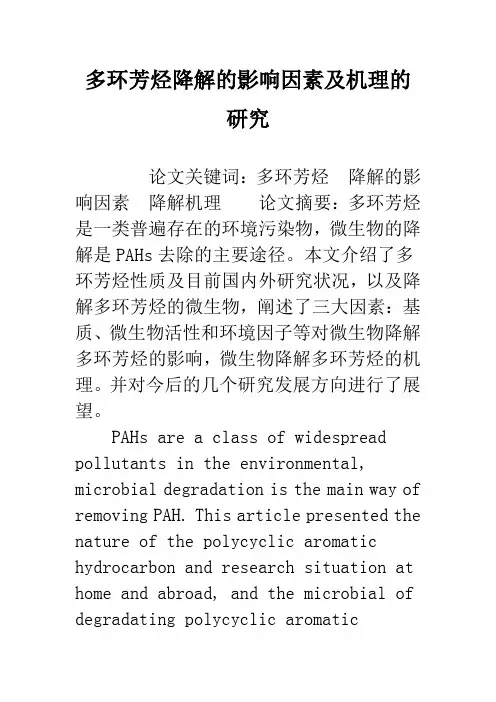
多环芳烃降解的影响因素及机理的研究论文关键词:多环芳烃降解的影响因素降解机理论文摘要:多环芳烃是一类普遍存在的环境污染物,微生物的降解是PAHs去除的主要途径。
本文介绍了多环芳烃性质及目前国内外研究状况,以及降解多环芳烃的微生物,阐述了三大因素:基质、微生物活性和环境因子等对微生物降解多环芳烃的影响,微生物降解多环芳烃的机理。
并对今后的几个研究发展方向进行了展望。
PAHs are a class of widespread pollutants in the environmental, microbial degradation is the main way of removing PAH. This article presented the nature of the polycyclic aromatic hydrocarbon and research situation at home and abroad, and the microbial of degradating polycyclic aromatichydrocarbon, analysis the three factors, such as matrix, microbial activity and environmental factors, on which the effects of microbial degradatation of polycyclic aromatic hydrocarbon, and the mechanism of microbial degradation of polycyclic aromatic hydrocarbon. Finally, forecasted a few research directions of future development.Key words: polycyclic aromatic hydrocarbon, degradation factors, degradation mechanism多环芳烃(Polycyclic aromatic hydrocarbons,PAHs)是环境中普遍存在的一类有机污染物,是指两个或两个以上苯环以线状、角状或簇状排列的稠环化合物,是有机物不完全燃烧或高温裂解的副产物[1]。
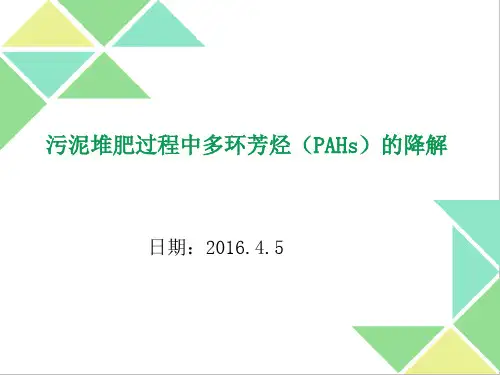
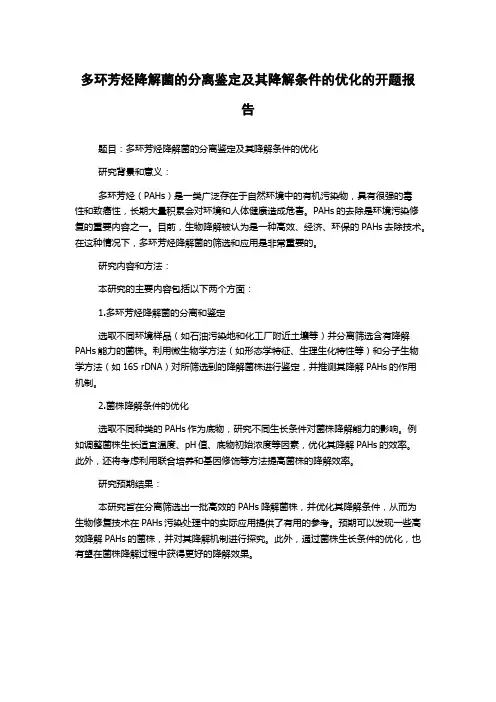
多环芳烃降解菌的分离鉴定及其降解条件的优化的开题报
告
题目:多环芳烃降解菌的分离鉴定及其降解条件的优化
研究背景和意义:
多环芳烃(PAHs)是一类广泛存在于自然环境中的有机污染物,具有很强的毒
性和致癌性,长期大量积累会对环境和人体健康造成危害。
PAHs的去除是环境污染修复的重要内容之一。
目前,生物降解被认为是一种高效、经济、环保的PAHs去除技术。
在这种情况下,多环芳烃降解菌的筛选和应用是非常重要的。
研究内容和方法:
本研究的主要内容包括以下两个方面:
1.多环芳烃降解菌的分离和鉴定
选取不同环境样品(如石油污染地和化工厂附近土壤等)并分离筛选含有降解PAHs能力的菌株。
利用微生物学方法(如形态学特征、生理生化特性等)和分子生物学方法(如16S rDNA)对所筛选到的降解菌株进行鉴定,并推测其降解PAHs的作用
机制。
2.菌株降解条件的优化
选取不同种类的PAHs作为底物,研究不同生长条件对菌株降解能力的影响。
例
如调整菌株生长适宜温度、pH值、底物初始浓度等因素,优化其降解PAHs的效率。
此外,还将考虑利用联合培养和基因修饰等方法提高菌株的降解效率。
研究预期结果:
本研究旨在分离筛选出一批高效的PAHs降解菌株,并优化其降解条件,从而为
生物修复技术在PAHs污染处理中的实际应用提供了有用的参考。
预期可以发现一些高效降解PAHs的菌株,并对其降解机制进行探究。
此外,通过菌株生长条件的优化,也有望在菌株降解过程中获得更好的降解效果。
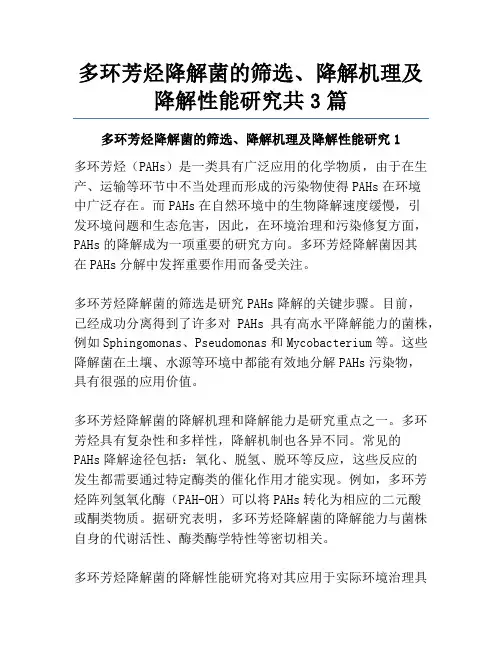
多环芳烃降解菌的筛选、降解机理及降解性能研究共3篇多环芳烃降解菌的筛选、降解机理及降解性能研究1多环芳烃(PAHs)是一类具有广泛应用的化学物质,由于在生产、运输等环节中不当处理而形成的污染物使得PAHs在环境中广泛存在。
而PAHs在自然环境中的生物降解速度缓慢,引发环境问题和生态危害,因此,在环境治理和污染修复方面,PAHs的降解成为一项重要的研究方向。
多环芳烃降解菌因其在PAHs分解中发挥重要作用而备受关注。
多环芳烃降解菌的筛选是研究PAHs降解的关键步骤。
目前,已经成功分离得到了许多对PAHs具有高水平降解能力的菌株,例如Sphingomonas、Pseudomonas和Mycobacterium等。
这些降解菌在土壤、水源等环境中都能有效地分解PAHs污染物,具有很强的应用价值。
多环芳烃降解菌的降解机理和降解能力是研究重点之一。
多环芳烃具有复杂性和多样性,降解机制也各异不同。
常见的PAHs降解途径包括:氧化、脱氢、脱环等反应,这些反应的发生都需要通过特定酶类的催化作用才能实现。
例如,多环芳烃阵列氢氧化酶(PAH-OH)可以将PAHs转化为相应的二元酸或酮类物质。
据研究表明,多环芳烃降解菌的降解能力与菌株自身的代谢活性、酶类酶学特性等密切相关。
多环芳烃降解菌的降解性能研究将对其应用于实际环境治理具有指导作用。
因为PAHs的化学结构复杂,降解过程中需要较高反应能量和完整的降解途径。
由于不同的菌株在PAHs降解稳定性、耐受性、适应性等方面存在差异,所以选择适合的菌株在实际应用中具有很高的重要性。
因此,深入研究PAHs降解菌株的降解性能,探究其在不同养分、温度、pH等环境变化下的生存、刺激响应和降解速率等特性,有助于更好地了解多环芳烃降解菌的整体性能和应用潜力,并为之后的环境修复工作提供更有针对性的建议和指导。
综上所述,多环芳烃降解菌的筛选、降解机理和降解性能研究对PAHs污染治理具有重要意义。
今后,研究人员将在这个领域展开更深入的研究,努力为保护环境、构建共享绿色家园做出贡献综合研究表明,多环芳烃降解菌的筛选、降解机理和降解性能研究是解决PAHs污染治理问题的重要途径。
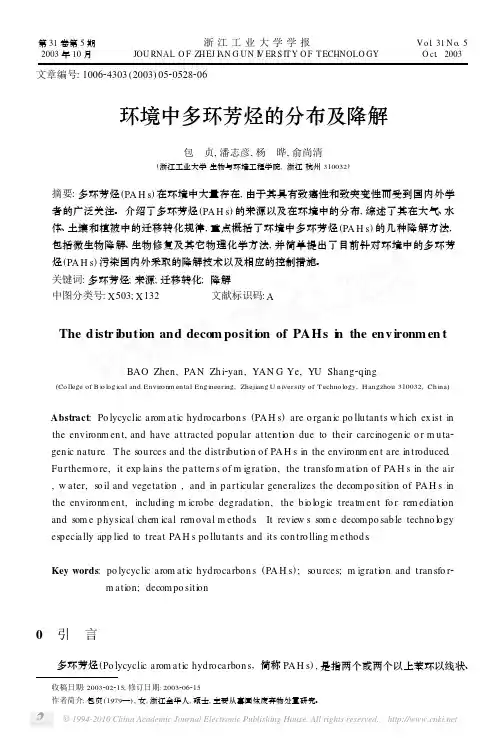
第31卷第5期2003年10月浙江工业大学学报JOU RNAL O F ZH EJ I AN G UN I V ER S IT Y O F T ECHNOLO GY V o l .31N o.5O ct .2003文章编号:100624303(2003)0520528206收稿日期:2003202215;修订日期:2003206215作者简介:包贞(1979—),女,浙江金华人,硕士,主要从事固体废弃物处置研究。
环境中多环芳烃的分布及降解包 贞,潘志彦,杨 晔,俞尚清(浙江工业大学生物与环境工程学院,浙江杭州310032)摘要:多环芳烃(PA H s )在环境中大量存在,由于其具有致癌性和致突变性而受到国内外学者的广泛关注。
介绍了多环芳烃(PA H s )的来源以及在环境中的分布,综述了其在大气、水体、土壤和植被中的迁移转化规律,重点概括了环境中多环芳烃(PA H s )的几种降解方法,包括微生物降解、生物修复及其它物理化学方法,并简单提出了目前针对环境中的多环芳烃(PA H s )污染国内外采取的降解技术以及相应的控制措施。
关键词:多环芳烃;来源;迁移转化;降解中图分类号:X 503;X 132 文献标识码:AThe d istr ibution and decom position of PAHs i n the env ironm en tBAO Zhen ,PAN Zh i 2yan ,YAN G Ye ,YU Shang 2qing(Co llege of B i o logical and Environm ental Engineering ,Zhejiang U niversity of T echno logy ,H angzhou 310032,Ch ina )Abstract :Po lycyclic arom atic hydrocarbon s (PA H s )are o rgan ic po llu tan ts w h ich ex ist in the environm en t ,and have attracted popu lar atten ti on due to their carcinogen ic o r m u ta 2gen ic natu re .T he sou rces and the distribu ti on of PA H s in the environm en t are in troduced .Fu rther m o re ,it exp lain s the pattern s of m igrati on ,the tran sfo r m ati on of PA H s in the air ,w ater ,so il and vegetati on ,and in p articu lar generalizes the decom po siti on of PA H s in the environm en t ,including m icrobe degradati on ,the b i o logic treatm en t fo r rem ediati on and som e p hysical chem ical rem oval m ethods .It review s som e decom po sab le techno logy especially app lied to treat PA H s po llu tan ts and its con tro lling m ethods .Key words :po lycyclic arom atic hydrocarbon s (PA H s );sou rces ;m igrati on and tran sfo r 2m ati on ;decom po siti on0 引 言多环芳烃(Po lycyclic arom atic hydrocarbon s ,简称PA H s ),是指两个或两个以上苯环以线状、角状或簇状排列的稠环化合物[1]。
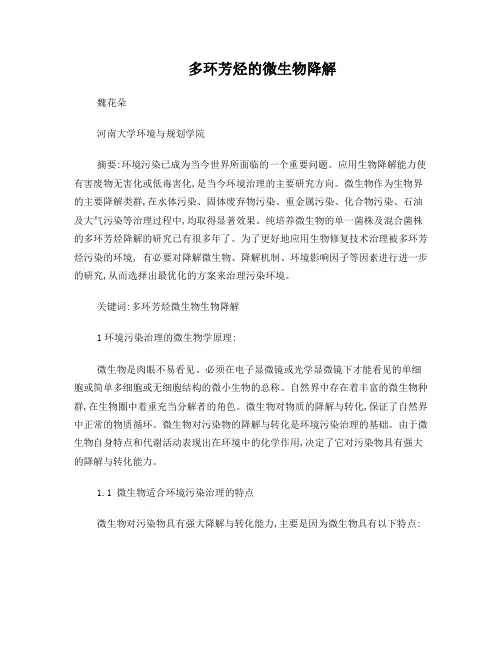
多环芳烃的微生物降解魏花朵河南大学环境与规划学院摘要:环境污染已成为当今世界所面临的一个重要问题。
应用生物降解能力使有害废物无害化或低毒害化,是当今环境治理的主要研究方向。
微生物作为生物界的主要降解类群,在水体污染、固体废弃物污染、重金属污染、化合物污染、石油及大气污染等治理过程中,均取得显著效果。
纯培养微生物的单一菌株及混合菌株的多环芳烃降解的研究已有很多年了。
为了更好地应用生物修复技术治理被多环芳烃污染的环境, 有必要对降解微生物、降解机制、环境影响因子等因素进行进一步的研究,从而选择出最优化的方案来治理污染环境。
关键词:多环芳烃微生物生物降解1环境污染治理的微生物学原理:微生物是肉眼不易看见、必须在电子显微镜或光学显微镜下才能看见的单细胞或简单多细胞或无细胞结构的微小生物的总称。
自然界中存在着丰富的微生物种群,在生物圈中着重充当分解者的角色。
微生物对物质的降解与转化,保证了自然界中正常的物质循环。
微生物对污染物的降解与转化是环境污染治理的基础。
由于微生物自身特点和代谢活动表现出在环境中的化学作用,决定了它对污染物具有强大的降解与转化能力。
1.1 微生物适合环境污染治理的特点微生物对污染物具有强大降解与转化能力,主要是因为微生物具有以下特点:1.1.1微生物个体微小,比表面积大,代谢速率快微生物的这个特点,使之具有惊人的代谢活性,有利于营养物的吸收和废物的排泄,有利于污染物的快速降解与转化。
1.1.2微生物种类多,分布广,代谢类型多样环境的多样性决定了微生物类型的多样性。
微生物种类多,代谢类型多样,为当今日益复杂的环境污染治理提供了更多的功能菌,对环境中形形色色的物质的降解转化,起着至关重要的作用。
1.1.3微生物繁殖快,易变异,适应性强微生物巨大的比表面积使之对生成条件下的变化具有极强的敏感性,加之微生物繁殖快、数量多,可在短时间内产生大量变异的后代,对进入环境中的“新”污染物,微生物可通过基因突变,改变原来的代谢类型而适应、降解之。
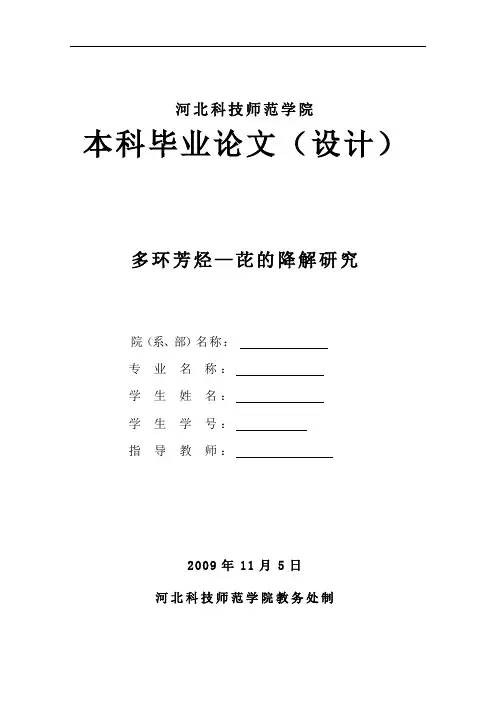
河北科技师范学院本科毕业论文(设计)多环芳烃—芘的降解研究院(系、部)名称:专业名称:学生姓名:学生学号:指导教师:2009年11月5日河北科技师范学院教务处制摘要多环芳烃是指分子中含有两个或两个以上苯环的碳氢化合物,多环芳烃是一类具有很强致癌性,致突变性和致畸性的环境污染物,具有低水溶性、高辛醇-水分配系数、高沉积物-水分配系数和较低的蒸汽压等特点。
它可以通过大气沉降、城市污水排放以及雨水冲刷作用进入水体,对整个生态系统的健康造成威胁,水体中多环芳烃呈3种状态:吸附于颗粒物、溶解态、悬浮态,是环境污染中最重要的检测项目之一,其已越来越受到人们的重视。
降解多环芳烃的方法有很多,常规方法有物理方法,化学方法等,物理法和普通的化学方法不仅降解的效果差,效率低,而且降解产物不彻底,光氧化法的降解效率高,产物稳定,具有很好的实际应用价值。
在光氧化过程中,水中的多环芳烃是在光诱发所产生的单线态氧、臭氧或羟基游离基的作用下发生氧化降解的。
本实验旨在观察在实验室中水萃效率最高时的实验条件以及在实验室控制的条件下多环芳烃降解的半衰期。
关键词:多环芳烃、光氧化、降解目录摘要 ....................................错误!未定义书签。
第1章文献综述 ...........................错误!未定义书签。
1.1 研究意义 .........................错误!未定义书签。
1.1.1 多环芳烃概述................错误!未定义书签。
1.1.2 多环芳香烃的来源与危害 (1)1.1.3 环境光化学基础 (2)1.2 多环芳烃的光降解 (3)1.3 研究进展 (4)1.3.1 PA HS光降解影响因素 (4)1.3.2多环芳烃分析测定 (5)1.4 主要研究内容 (6)第二章、实验部分 (6)2.1实验材料与方法 (6)2.2实验仪器与试剂 (7)2.2.1实验仪器设备 (7)2.2.2实验试剂 (7)2.3反应溶液介质和溶液的配制 (8)2.4实验步骤 (8)2.5质量控制与质量保证 (10)2.6色谱条件 (11)第三章、实验结果与讨论 ..................错误!未定义书签。
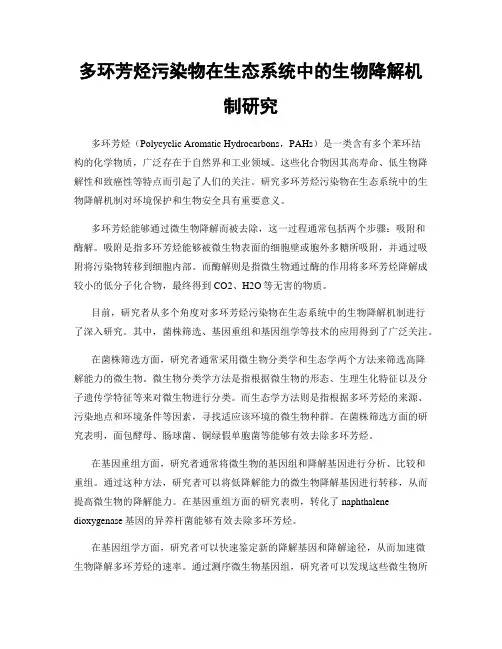
多环芳烃污染物在生态系统中的生物降解机制研究多环芳烃(Polycyclic Aromatic Hydrocarbons,PAHs)是一类含有多个苯环结构的化学物质,广泛存在于自然界和工业领域。
这些化合物因其高寿命、低生物降解性和致癌性等特点而引起了人们的关注。
研究多环芳烃污染物在生态系统中的生物降解机制对环境保护和生物安全具有重要意义。
多环芳烃能够通过微生物降解而被去除,这一过程通常包括两个步骤:吸附和酶解。
吸附是指多环芳烃能够被微生物表面的细胞壁或胞外多糖所吸附,并通过吸附将污染物转移到细胞内部。
而酶解则是指微生物通过酶的作用将多环芳烃降解成较小的低分子化合物,最终得到CO2、H2O等无害的物质。
目前,研究者从多个角度对多环芳烃污染物在生态系统中的生物降解机制进行了深入研究。
其中,菌株筛选、基因重组和基因组学等技术的应用得到了广泛关注。
在菌株筛选方面,研究者通常采用微生物分类学和生态学两个方法来筛选高降解能力的微生物。
微生物分类学方法是指根据微生物的形态、生理生化特征以及分子遗传学特征等来对微生物进行分类。
而生态学方法则是指根据多环芳烃的来源、污染地点和环境条件等因素,寻找适应该环境的微生物种群。
在菌株筛选方面的研究表明,面包酵母、肠球菌、铜绿假单胞菌等能够有效去除多环芳烃。
在基因重组方面,研究者通常将微生物的基因组和降解基因进行分析、比较和重组。
通过这种方法,研究者可以将低降解能力的微生物降解基因进行转移,从而提高微生物的降解能力。
在基因重组方面的研究表明,转化了naphthalene dioxygenase基因的异养杆菌能够有效去除多环芳烃。
在基因组学方面,研究者可以快速鉴定新的降解基因和降解途径,从而加速微生物降解多环芳烃的速率。
通过测序微生物基因组,研究者可以发现这些微生物所拥有的各种降解途径和蛋白质。
在基因组学方面的研究表明,依靠微生物基因组的分析,可以快速鉴定降解基因和降解途径,例如海洋细菌Marinobacter sp.和Mycolicibacterium strain CU5能够降解多环芳烃。
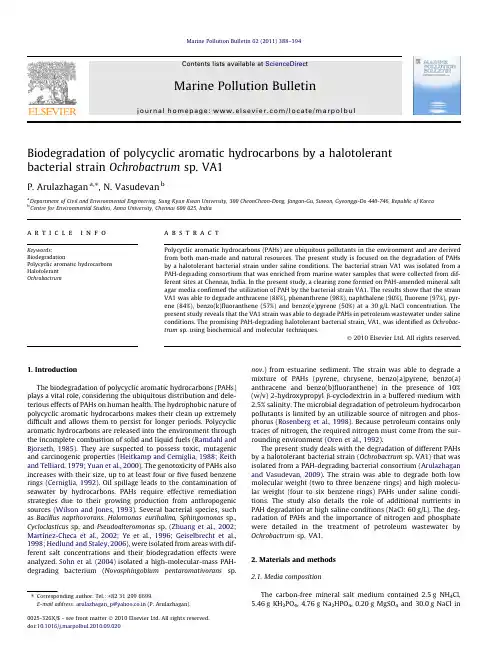
Biodegradation of polycyclic aromatic hydrocarbons by a halotolerant bacterial strain Ochrobactrum sp.VA1P.Arulazhagan a ,⇑,N.Vasudevan ba Department of Civil and Environmental Engineering,Sung Kyun Kwan University,300CheonCheon-Dong,Jangan-Gu,Suwon,Gyeonggi-Do 440-746,Republic of Korea bCentre for Environmental Studies,Anna University,Chennai 600025,Indiaa r t i c l e i n f o Keywords:BiodegradationPolycyclic aromatic hydrocarbons Halotolerant Ochrobactruma b s t r a c tPolycyclic aromatic hydrocarbons (PAHs)are ubiquitous pollutants in the environment and are derived from both man-made and natural resources.The present study is focused on the degradation of PAHs by a halotolerant bacterial strain under saline conditions.The bacterial strain VA1was isolated from a PAH-degrading consortium that was enriched from marine water samples that were collected from dif-ferent sites at Chennai,India.In the present study,a clearing zone formed on PAH-amended mineral salt agar media confirmed the utilization of PAH by the bacterial strain VA1.The results show that the strain VA1was able to degrade anthracene (88%),phenanthrene (98%),naphthalene (90%),fluorene (97%),pyr-ene (84%),benzo(k)fluoranthene (57%)and benzo(e)pyrene (50%)at a 30g/L NaCl concentration.The present study reveals that the VA1strain was able to degrade PAHs in petroleum wastewater under saline conditions.The promising PAH-degrading halotolerant bacterial strain,VA1,was identified as Ochrobac-trum ing biochemical and molecular techniques.Ó2010Elsevier Ltd.All rights reserved.1.IntroductionThe biodegradation of polycyclic aromatic hydrocarbons (PAHs)plays a vital role,considering the ubiquitous distribution and dele-terious effects of PAHs on human health.The hydrophobic nature of polycyclic aromatic hydrocarbons makes their clean up extremely difficult and allows them to persist for longer periods.Polycyclic aromatic hydrocarbons are released into the environment through the incomplete combustion of solid and liquid fuels (Ramdahl and Bjorseth,1985).They are suspected to possess toxic,mutagenic and carcinogenic properties (Heitkamp and Cerniglia,1988;Keith and Telliard,1979;Yuan et al.,2000).The genotoxicity of PAHs also increases with their size,up to at least four or five fused benzene rings (Cerniglia,1992).Oil spillage leads to the contamination of seawater by hydrocarbons.PAHs require effective remediation strategies due to their growing production from anthropogenic sources (Wilson and Jones,1993).Several bacterial species,such as Bacillus napthovorans ,Halomonas eurihalina,Sphingomonas sp.,Cycloclasticus sp.and Pseudoalteromonas sp.(Zhuang et al.,2002;Martínez-Checa et al.,2002;Ye et al.,1996;Geiselbrecht et al.,1998;Hedlund and Staley,2006),were isolated from areas with dif-ferent salt concentrations and their biodegradation effects were analyzed.Sohn et al.(2004)isolated a high-molecular-mass PAH-degrading bacterium (Novosphingobium pentaromativorans sp.nov.)from estuarine sediment.The strain was able to degrade a mixture of PAHs (pyrene,chrysene,benzo(a)pyrene,benzo(a)anthracene and benzo(b)fluoranthene)in the presence of 10%(w/v)2-hydroxypropyl b -cyclodextrin in a buffered medium with 2.5%salinity.The microbial degradation of petroleum hydrocarbon pollutants is limited by an utilizable source of nitrogen and phos-phorus (Rosenberg et al.,1998).Because petroleum contains only traces of nitrogen,the required nitrogen must come from the sur-rounding environment (Oren et al.,1992).The present study deals with the degradation of different PAHs by a halotolerant bacterial strain (Ochrobactrum sp.VA1)that was isolated from a PAH-degrading bacterial consortium (Arulazhagan and Vasudevan,2009).The strain was able to degrade both low molecular weight (two to three benzene rings)and high molecu-lar weight (four to six benzene rings)PAHs under saline condi-tions.The study also details the role of additional nutrients in PAH degradation at high saline conditions (NaCl:60g/L).The deg-radation of PAHs and the importance of nitrogen and phosphate were detailed in the treatment of petroleum wastewater by Ochrobactrum sp.VA1.2.Materials and methods 2.1.Media compositionThe carbon-free mineral salt medium contained 2.5g NH 4Cl,5.46g KH 2PO 4,4.76g Na 2HPO 4,0.20g MgSO 4and 30.0g NaCl in0025-326X/$-see front matter Ó2010Elsevier Ltd.All rights reserved.doi:10.1016/j.marpolbul.2010.09.020Corresponding author.Tel.:+82312996699.E-mail address:arulazhagan_p@yahoo.co.in (P.Arulazhagan).1L distilled water,pH7.4±0.2.Thefinal pH of the medium was adjusted to7.4with0.1N NaOH,and the medium was sterilized by autoclaving(121°C for15min)prior to the addition of the PAHs substrates.Stock solutions of each PAH were prepared in ethyl ace-tate and stored at4°C.2.2.PAHsThe PAHs were purchased from Sigma–Aldrich(98–99%purity), and all other chemicals(Analar grade)were purchased from Merck, India.The PAHs used in the study were selected based on the num-ber of rings(two to six benzene rings)and their molecular weights. The molecular weights of the PAHs used in the study were naph-thalene(128),fluorene(166),phenanthrene(178),anthracene (178),pyrene,benzo(e)pyrene and benzo(k)fluoranthene.The con-centrations of PAHs used were3ppm anthracene,3ppm phenan-threne,3ppm naphthalene,3ppmfluorene,3ppm pyrene, 1ppm benzo(e)pyrene and1ppm benzo(k)fluoranthene.Anthra-cene and pyrene were selected as representatives of LMW and HMW PAHs,respectively,for studies at different concentrations (25,50,75and100ppm).2.3.Bacterial strainThe PAH-degrading bacterial consortium was enriched from water samples collected from seven different petroleum-or coal-contaminated sites from the port of Chennai,India(Arulazhagan and Vasudevan,2009).The bacterial strain Ochrobactrum sp.VA1 was isolated from the PAHs-degrading bacterial consortium.The bacterial strain(VA1)was grown on phenanthrene,and the cell count was checked daily and during every transfer to fresh med-ium.The cell morphology and motility of exponentially growing li-quid cultures were examined on freshly prepared wet mounts by light microscopy.Plate counting was done in nutrient agar medium.2.4.Enrichment of bacterial strainThe PAH phenanthrene dissolved in ethyl acetate was added to 250mL conicalflasks.After the ethyl acetate had evaporated,the mineral medium(100mL)was added.The bacterial cells(5mL) were added to the mineral medium containing the PAH(phenan-threne,3ppm)as the sole carbon source.The conicalflasks were shaken at150rpm at37°C for48h.After the growth was visual-ized,5mL of enrichment cultures were then transferred to a fresh medium and incubated under the same conditions.Subsequently, three to four identical transfers were performed in the respective PAH-containing medium.2.5.PAH clearing zone-spray-plate techniquePAH degradation by the bacterial strain was analyzed by the spray-plate technique using the PAH as the sole carbon and energy source.Agar was added to the mineral salt medium for plating in Petri dishes.After solidification,acetone-dissolved anthracene was sprayed on top of the medium.The bacterial strain was inoc-ulated on the PAH amended medium and incubated at37°C for 48h.After incubation,the clearing zones formed around the colo-nies indicated the degradation of the PAH sprayed on the medium (Kiyohara et al.,1982).2.6.Analysis of PAH degradationFor the degradation study,the bacterial strain was inoculated in mineral medium containing PAH.The different compositions used in the degradation of PAH were(i)medium+PAH+bacterial strain;(ii)medium+PAH and(iii)medium+bacterial strain, where(ii)and(iii)served as controls.The bacterial strain was added to the medium at a concentration of104–105cfu/mL.The cultures,prepared in duplicate,were incubated at37°C in a shaker at150rpm and were extracted at every24h time interval for 5days.The samples were extracted twice with ethyl acetate(v/v) after acidification to pH2.5with1N HCl.The extracts werefiltered through anhydrous sodium sulfate and condensed to1mL for the chromatographical analysis of PAH degradation using a condensa-tion unit(Buchi,Germany).The condensed sample wasfiltered through a0.2-mm syringe filter and was analyzed using high performance liquid chromatog-raphy(HPLC).HPLC analysis was performed with a KNAUER(K501, Knauer,Germany)unit equipped with a PAH-specific column(Ultr-asep ES,B590/02,250Â4mm,Knauer,Germany)with a UV–VIS detector connected to the WINCHROME software,which was used to process the data.The mobile phase was acetonitrile.Standard solutions of different PAHs were used as a reference.Theflow rate of the mobile phase was maintained at1mL/min.The samples were injected individually,and the utilization rate of PAHs was cal-culated based on the peak area percent and the retention time.2.7.Metabolite formation-TLC and GCMSDuring the degradation study,different kinds of metabolites were formed;these metabolites were identified using thin layer chromatography(TLC).The condensed samples were loaded on a TLC plate with the help of capillary tubes(10l L).The chromato-gram was run with solvents in ratios as follows:50:50benzene/ hexane,50:50benzene/acetone and80:10:10benzene/acetone/ acetic acid.After removing the plates from the solvents,2%Gibbs reagent was sprayed on the plate,and the plate was observed un-der ultraviolet light at265nm to identify the PAH metabolites.A Hewlett–Packard6890gas chromatograph,equipped with a 5973mass spectrometer with an HP-5MS(30mÂ0.25mm I.D.Â0.25l m)fused-silica capillary column,was used for the analysis.The column temperature program was set at100°C held for1min,15°C/min to160°C and5°C/min to300°C held for 7min.The GC injector was held isothermally at280°C with a split-less period of3min.Helium was used as the carrier gas at aflow rate of1ml/min using electronic pressure control.The GC/MS interface temperature was maintained at280°C.The MS was oper-ated in electron impact(EI)ionization mode with an electron en-ergy of70eV,and the scan to determine the appropriate masses for the selected ion monitoring ranged from50to500amu(atom to mass unit).Standards from Sigma–Aldrich were used for the PAH(Fluorene)and their metabolites.A GC–MS library search was used to confirm the metabolites without standards.2.8.CO2evolution testIn this study,PAH+MSM and MSM+VA1bacterial strain served as the controls and PAH+MSM+VA1bacterial strain was used as the test sample.Mineral salt medium,in combination with both PAH and the VA1bacterial strain,was used as the sample. PAH(3ppm phenanthrene)dissolved in ethyl acetate was added to sterile saline bottles(100mL).After the evaporation of the sol-vent,25mL of mineral salts medium was added to the bottle. The bottle was completely sealed(airtight)with an aluminum stopper.The medium was kept in an orbital shaker at150rpm. Samples were collected at24h time intervals and analyzed for CO2evolution in a gas chromatograph.The carbon dioxide content was measured in a Porapak Q column(80/100mesh,2m)with a thermal conductivity detector using an external standard.The carrier gas was helium,and the column temperature was50°C. The temperature of the injector and of the detector was100°C.P.Arulazhagan,N.Vasudevan/Marine Pollution Bulletin62(2011)388–394389Samples(250l L)of the headspace gas of the cultureflask were withdrawn with a gas-tight syringe and injected into the gas chro-matograph for CO2determination.The samples in the saline bottles were extracted and analyzed on a PAH-specific column using HPLC to measure the degradation of PAH.b-scale study on the treatment of petroleum wastewaterA lab-scale study using petroleum wastewater(produced water)from Cairn Energy Private Limited,India,with2.9%salinity was conducted in a500mLflask.The nitrogen and phosphate lev-els in the wastewater were5.6ppm and3.9ppm,respectively.Due to the low concentration of nutrients,the bacterial strain VA1was unable to grow on PAHs present in the wastewater.To support and enhance the growth of VA1,ammonium chloride(0.03g/L)and potassium dihydrogen phosphate(0.015g/L)were added to the wastewater.2.10.Phenotypic and phylogenetic analysisThe bacterial strain was analyzed for phenotypic characters using KB003:Hi24‘‘Enterobacteriaceae Identification Kit”, (Himedia,India).The phenotypic characteristics of the strain were analyzed using the Enterobacteriaceae Identification Kit to confirm the utilization of different carbon sources and also to identify the genus of the strain.2.11.Extraction and amplification of bacterial DNADNA from the bacterial cells was extracted using a Qiagen(QIA-ampÒDNA stool Mini kit Cat.No.51504)DNA isolation ing the protocol from the manufacturer,DNA was eluted in200l L of AE buffer and stored at4°C for further use.The concentrated DNA samples were amplified by polymerase chain reaction(PCR) using a thermal cycler(MastercyclerÒpersonal,Eppendorf AG,Ger-many).Amplification was performed using a forward primer(27F) and a reverse primer(1520R)that are complementary to highly conserved regions of bacterial16S rRNA genes.The sequence of the forward primer(25pmol)was50-AGAGTTTGATCCTGGCTCAG-30(hybridizing at positions8–27,according to the Escherichia coli numbering system),and the sequence of the reverse primer (25pmol)was50-AAGGAGGTGATCCAGCCGCA-30(hybridizing at positions1541–1522),for a combined concentration of50pmol. The PCR supermix(Invitrogen Cat.No.10572-014,USA)consisted of22mM Tris–HCl(pH8.4),55mM KCl,1.65mM MgCl2,220l M dGTP,220l M dATP,220l M dTTP,220l M dCTP and22U recom-binant Taq DNA polymerase/mL.The PCR supermix(40l L)was mixed with the primers(5l L)and the DNA(5l L)for a total vol-ume of50l L in0.2mL PCR tubes and was then loaded in the ther-mal cycler.The PCR was performed with an initial denaturation at 94°C for3min,followed by30cycles of denaturation at94°C for 1min,primer annealing at60°C for0.45min,and primer exten-sion at72°C for2min.For thefinal step,the samples were incu-bated at72°C for10min.PCR amplification was verified by electrophoresis,performed in a horizontal submarine apparatus with1%agarose gel.TAE buffer was used as the tank buffer.The electrophoresis was performed for2h at50V.The gel was visual-ized in an UV illuminator.3.16S rRNA sequential analysis of the PAH-degrading bacterial strainThe cyclic sequencing reaction was performed using the BigDye TerminatorV3.1cycle sequencing kit containing Ampli Taq DNA polymerase(Applied Biosystems,P/N:4337457).The sequencing reaction mix was prepared by combining1l L of BigDyeV3.1, 2l L of5Âsequencing buffer and1l L of50%DMSO.To4l L of sequencing reaction mix,4pmol of primer(2l L)and a sufficient amount of purified PCR product was added.The resulting solution was denatured at95°C for5min.Cycling began by denaturing at 95°C for30s,annealing at52°C for30s and extension for4min at60°C;the cycle was repeated a total of30times in an MWG thermocycler.The reaction was then purified on a Sephadex plate (Edge Biosystems),and centrifugation was used to remove un-bound labeled and unlabeled nucleotides and salts.The purified reaction was loaded onto the96capillary ABI3700automated DNA analyzer,and electrophoresis was carried out for4h.The nucleotide sequences were registered in the computer that is at-tached to the ABI3700DNA analyzer.The nucleotide sequences obtained from the ABI DNA analyzer were studied using the BLAST software available on the NCBI web-site().After editing the sequence,the BLAST software was used to identify the specific type of bacterium corre-sponding to the nucleotide sequence.4.ResultsThis study was conducted to understand the degradation of dif-ferent PAHs at different concentrations by the halotolerant bacte-rial strain(Ochrobactrum sp.VA1)under saline conditions.The study also details the importance of additional substrates for PAH degradation at higher salinity.4.1.Isolation of the PAH-degrading bacterial strainThe bacterial consortium that was enriched from the marine environment contained three bacterial strains(VA1,VA2and VA3).Among the three bacterial strains,strain VA1grew better on different LMW PAHs than did VA2and VA3.When the strain VA1was grown on PAH-coated(anthracene)mineral agar plates, clearing zones were visualized,indicating the PAH-utilizing ability of the strain.Clearing zones on mineral salts medium coated with PAH(anthracene)were analyzed for the VA1strain using Gordona sp.BP9as a positive control.A clearing zone of1.8mm diameter was observed for the positive control,whereas for the VA1strain, it was2.1mm on anthracene.Thin layer chromatographic analysis revealed that VA1was able to degrade PAHs.Different colored spots indicated the metabolite formation.The amount of CO2pro-duced in the controlflask with the VA1strain and medium was 152ppmv.The ratio between the amount of carbon dioxide pro-duced and the residual hydrocarbons gives a complete picture of the hydrocarbon degradation(Penet et al.,2004).The stoichiome-tric equation used to calculate the amount of CO2produced during phenanthrene(C14H10)degradation was as follows:2C14H10þ33O2!28CO2þ10H2OThe study confirms the mineralization potential of the bacterial strain to degrade phenanthrene as a sole carbon source in30g/L NaCl.The bacterial strain VA1degraded phenanthrene(92%)and released1274ppmv CO2(Fig1).Duringfluorene(3ppm)degradation,the different metabolites formed were analyzed using thin layer chromatography(TLC).The samples collected on the fourth day showed different colored spots on the TLC plate,which indicated the metabolite formation.The formation of metabolites during the mineralization offluorene was further confirmed by GC–Mass Spectral analysis(Table1). The analysis showed six peaks,out of which two peaks were con-firmed as monohydroxyfluorene(m/z,254),fluorenone(m/z,310) and phthalic acid(m/z,310).390P.Arulazhagan,N.Vasudevan/Marine Pollution Bulletin62(2011)388–394Fig.3.Degradation of naphthalene by Ochrobactrum sp.VA1(NaCl:30g/L).Fig.4.Degradation offluorene by Ochrobactrum sp.VA1(NaCl:30g/L). Fig.2.Degradation of anthracene by Ochrobactrum sp.VA1(NaCl:30g/L).7.Degradation of benzo(k)fluoranthene by Ochrobactrum sp.VA1(NaCl:30g/L).Fig.9.Treatment of petroleum wastewater using Ochrobactrum sp.VA1.oxidase positive.The strain grows at37°C and at pH7.4.When the strain was analyzed for physiological characteristics,the strain showed negative results for ONPG,phenylalanine deamination, methyl red,Voges-Proskauer and indole reactions.The strain uti-lized9out of13carbon sources.Arabinose,adonitol,trehalose and lactose are the carbon sources that were not utilized by the strain(Table4).Thus,based on the phylogenetic analysis and phe-notypic characterization,the bacterial strain VA1has been identi-fied as Ochrobactrum sp.5.DiscussionThe halotolerant,PAHs-degrading bacterial strain,Ochrobac-trum sp.VA1,was isolated from a PAH-degrading bacterial consor-tium.Among the three bacterial strains present in the consortium, strain VA1showed more potential growth and degradation of PAHs than strains VA2(Enterobacter cloacae)and VA3(Stenotrophomonas maltophilia).The strain VA1also potentially degraded different concentrations of LMW and HMW PAHs and the PAHs present in petroleum wastewater under saline conditions.Initially,degradation of PAH by the VA1strain was confirmed using clearing zones formed on anthracene-coated mineral salt agar medium.Further studies on the mineralization of PAH,based on CO2evolution by the bacterial strain,proved the degradation. During the mineralization of PAHs,the amount of CO2evolved indicates the extent of degradation(Solano-Serena et al.,1999). Bouchez et al.(1996)reported that the complete degradation of PAH results in the evolution of CO2,the formation of biomass and water-soluble metabolites.The bacterial strain used in the present study utilized phenanthrene(92%)as a sole carbon source and released1274ppmv of CO2.The stoichiometrically calculated amount of CO2that evolved during phenanthrene degradation was almost equal to90%of phenanthrene converted into CO2. The degradation of PAH by the bacterial strain was enhanced by the addition of substrate to the medium.The complete mineralization of PAH by the bacterial strain was further confirmed by analyzing the metabolites formed duringflu-orene degradation.Metabolites,such as monohydroxyfluorene,fluorenone and phthalic acid,forfluorene-utilizing bacteria,were also reported for Pseudomonas sp.F274(Grifoll et al.,1994).Phtha-lic acid that is formed duringfluorene degradation may be further degraded to CO2and water(Yamazoe et al.,2004).Thus,in the present study,the formation of such metabolites may be due to enzymatic action on the PAHs.LMW and HMW PAHs were used as sole carbon sources for the growth of the VA1bacterial strain.VA1degraded more than85%of LMW PAHs in4days at30g/L NaCl,except for anthracene(5days), which showed that LMW PAHs are easily degraded by VA1.The re-sults depicted in Figs.3–5show the degradation of naphthalene (3ppm),fluorene(3ppm)and phenanthrene(3ppm)by the VA1 strain at89%,97%and92%,respectively.Moody et al.(2001)re-ported that the Mycobacterium sp.strain PYR-1was dosed with anthracene or phenanthrene and,after14days of incubation,had degraded92%and90%of the added anthracene and phenanthrene.The strain Ochrobactrum sp.VA1was also found to be effective in degrading the HMW PAHs,such as pyrene(84%),benzo(k)fluo-ranthene(57%)and benzo(e)pyrene(51%).An increase in the molecular weight decreased the percent degradation of PAHs by the bacterial strain.Martínez-Checa et al.(2002)reported that the Halomonas eurihalina strain H-28was able to grow and produce surfactant on different carbon sources(n-hexadecane,petrol, n-tetradecane and crude oil)in the presence of glucose,yeast extract,malt extract and proteose-peptone at51.3g/L NaCl.The strain degraded naphthalene(95%),phenanthrene(50%),fluo-ranthene(50%)and pyrene(58%).Daane et al.(2001)reported that the bacterial strain Paenibacillus group-PR-P3,isolated from the rhizosphere of salt marsh plants,degraded the naphthalene and phenanthrene that was present in the sediments completely.They also reported that71%of thefluorene was degraded by the Paeni-bacillus group-PR-P1strain.Pseudomonas cepacia F297is able to grow withfluorene as the sole source of carbon and energy(Grifoll et al.(1995).Hedlund et al.(1999)reported that the Neptunomonas naphthovorans(NAG-2N-113and NAG-2N-126)strains,isolated from creosote-contaminated sediments,were capable of degrading 5ppm naphthalene completely in7days.When compared to the above reports,the halotolerant strain VA1used in the present study degraded both LMW and HMW PAHs under saline conditions without any additional substrate.Salinity plays an important role in the treatment of petroleum wastewater.When the salinity of the medium was increased to 60g/L NaCl,the percent degradation of PAHs decreased,and the need for additional substrates occurred(Kargi and Dincer,1996). To support the growth of the bacterial strain,yeast extract(0.2g/L) was added to the medium.The addition of yeast extract enhanced the percent degradation of the PAHs by Ochrobactrum sp.at60g/L NaCl.Thus,the need for additional substrate for PAH degradation at high salinity is reported from this study.The need for additional substrate has been emphasized previously(Kargi and Dincer,1996).The strain VA1was also studied at different concentrations of PAHs(anthracene and pyrene),and the results showed above 60%degradation up to75ppm.When the concentration of PAH in-creased to100ppm,the percent degradation decreased.Zhuang et al.(2002)reported that Bacillus naphthovorans MN-003,isolated from marine fuel oil-contaminated tropical marine sediments (optimum salinity1.75–3.50%),was used in a bioreactor to treat naphthalene-contaminated seawater at a removal rate of0.8g/L/ day.Kumar et al.(2007)isolated a halotolerant and thermotolerant Bacillus sp.,which degraded a mixture of hydrocarbons(0.02%) with diesel,gas oil,alkanes,crude oil and kerosene(0.2%)The strain also produced a surface-active emulsifying pared to the previous reports,the strain Ochrobactrum sp.VA1used in the present study degraded PAHs without any additional substrate at 30g/L NaCl.In the lab scale petroleum wastewater study,due to the low concentration of nitrogen and phosphate,the strain was unableTable4Phenotypic analysis of PAHs degrading Ochrobactrum sp.VA1strain. of the biochemical test VA11.Oxidase+2.ONPGÀ3.Lysine decarboxylase+4.Ornithine+5.Urease+6.Phenylalanine deaminationÀ7.Nitrate reductionÀ8.H2S production+9.Citrate utilization+10.Methyl redÀ11.Voges ProskauresÀ12.IndoleÀ13.Malonate+14.Esculin+15.ArabinoseÀ16.Xylose+17.AdonitolÀ18.Rhamnose+19.Cellobiose+20.Melibiose+21.Saccharose+22.Raffinose+23.TrehaloseÀ24.Glucose+ctoseÀONPG–ortho nitro phenylene b-galactopyranoside.P.Arulazhagan,N.Vasudevan/Marine Pollution Bulletin62(2011)388–394393to degrade PAHs.Therefore,the addition of nutrients(nitrogen and phosphate)for the degradation of PAHs under saline condi-tions was detailed.With this addition of nutrients,Ochrobactrum sp.VA1was also found to be potent in the degradation of PAHs in petroleum wastewater.The strain was capable of reducing66% of COD and effectively degraded PAHs(fluorene and benzo(e)pyr-ene)in the petroleum wastewater.Based on the phylogenetic analysis and phenotypic characterization,it was confirmed that the PAH degrading isolate VA1belongs to the Ochrobactrum sp. According to the earlier reports by Holmes et al.(1988),El-Sayed et al.(2003),Lebuhn et al.(2000),and Trujillo et al.(2005),the phenotypic results in the present study confirmed that the stain belongs to Ochrobactrum sp.The strain VA2was identified as Enterobacter cloacae,based on the phenotypic characteristics re-ported by Saadoun(2002),who isolated Enterobacter cloacae from soil capable of growing on diesel.The bacterial strain VA3was identified as Stenotrophomonas maltophilia,based on the pheno-typic characteristics reported by Juhasz et al.(2000),who iso-lated the Stenotrophomonas maltophilia strain VUN10,003from soil near port Melbourne,Australia for its potential in the degra-dation of HMW PAHs.The Ochrobactrum strain isolated by El-Sayed et al.(2003)was capable of degrading phenol(100ppm). The gene sequences of the strains were submitted to GenBank, and the respective accession numbers are EU722312(Ochrobac-trum sp.VA1),EU722313(Enterobacter cloacae VA2)and EU722314(Stenotrophomonas maltophilia VA3)(Arulazhagan and Vasudevan,2009).From the present study,it may be concluded that the Ochrobac-trum sp.strain VA1(EU722312)is halotolerant and capable of degrading both LMW and HMW PAHs under saline conditions. The study also reveals that the degradation of PAHs by this bacte-rial strain was highly influenced by limiting factors such as salinity, available nutrients and the concentration of the PAHs.The halotol-erant bacterial strain Ochrobactrum sp.VA1,which is capable of degrading PAHs,can be employed in the treatment of PAH contam-ination in marine environments.ReferencesArulazhagan,P.,Vasudevan,N.,2009.Role of moderately halophilic bacterial consortium in biodegradation of polyaromatic hydrocarbons.Mar.Pollut.Bull.58(2),256–262.Bouchez,M.,Blanchet,D.,Vandecasteele,J.P.,1996.The microbiological fate of polycyclic aromatic hydrocarbons:carbon and oxygen balances for bacterial degradation of model compounds.Appl.Microbiol.Biotechnol.45,556–561. Cerniglia, C.E.,1992.Biodegradation of polycyclic aromatic hydrocarbons.Biodegradation3,351–368.Daane,L.L.,Harjono,I.,Zylstra,G.J.,Haggblom,M.M.,2001.Isolation and characterization of polycyclic aromatic hydrocarbon-degrading bacteria associated with the rhizosphere of salt marsh plants.Appl.Environ.Microbiol.67(6),2683–2691.El-Sayed,W.S.,Ibrahim,M.K.,Mohamed,Abu.-Shady,El-Beih,F.,Ohmura,N.,Saiki,H.,Ando,A.,2003.Isolation and identification of a novel strain of the genusOchrobactrum with phenol-degrading activity.J.Biosci.Bioeng.96(3),310–312. Geiselbrecht,A.D.,Hedlund,B.P.,Tichi,M.A.,Staley,J.T.,1998.Isolation of marine polycyclic aromatic hydrocarbon(PAH)-degrading Cycloclasticus strains from the Gulf of Mexico and comparison of their PAH degradation ability with that of Puget Sound Cycloclasticu s strains.Appl.Environ.Microbiol.64,4703–4710. Grifoll,M.,Selifonov,S.A.,Chapman,P.J.,1994.Evidence for a novel pathway in the degradation offluorene by Pseudomonas sp.strain F274.Appl.Environ.Microbiol.60,2438–2449.Grifoll,M.,Selifonov,S.A.,Gatlin,C.V.,Chapman,P.J.,1995.Actions of a versatile fluorene-degrading bacterial isolate on polycyclic aromatic compounds.Appl.Environ.Microbiol.61(10),3711–3723.Hedlund,B.P.,Geiselbrecht,A.D.,Staley,J.T.,1999.Polycyclic aromatic hydrocarbon degradation by a new marine bacterium,Neptunomonas naphthovorans gen.Nov.,sp.nov.Appl.Environ.Microbiol.65,251–259.Hedlund,B.P.,Staley,J.T.,2006.Isolation and characterization of Pseudoalteromonas strains with divergent polycyclic aromatic hydrocarbon catabolic properties.Environ.Microbiol.8(1),178–182.Heitkamp,M.A.,Cerniglia, C.E.,1988.Mineralization of polycyclic aromatic hydrocarbons by a bacterium isolated from sediment below an oilfield.Appl.Environ.Microbiol.54,1612–1614.Holmes,B.,Popoff,M.,Kiredjian,M.,Kersters,K.,1988.Ochrobactrum anthropi gen.nov.,sp.nov.from human clinical specimens and previously known as group Vd.Int.J.Syst.Bacteriol.38,406–416.Juhasz,A.L.,Stanley,G.A.,Britz,M.L.,2000.Microbial degradation and detoxification of high molecular weight polycyclic aromatic hydrocarbons by Stenotrophomonas maltophikia strain VUN1003.Lett.Appl.Microbiol.30,396–401.Kargi,F.,Dincer,A.R.,1996.Effect of salt concentration on biological treatment of saline wastewater by fed-batch operation.Enzyme Microb.Technol.19(7), 529–537.Keith,L.H.,Telliard,W.A.,1979.Priority pollutants.I.A perspective view.Environ.Sci.Technol.13,416–423.Kiyohara,H.,Nagao,K.,Yana,K.,1982.Rapid screen for bacteria degrading water-insoluble,solid hydrocarbons on agar plates.Appl.Environ.Microbiol.43,454–457.Kumar,M.,Vladimir,L.,Angela, D.S.M.,Olaf, A.I.,2007.A halotolerant and thermotolerant Bacillus sp.degrades hydrocarbons and produces tensio-active emulsifying agent.World J.Microbiol.Biotechnol.23,211–220.Lebuhn,M.,Achouak,W.,Schloter,M.,Berge,O.,Meier,H.,Barakat,M.,Hartmann,A.,Heulin,T.,2000.Taxonomic characterization of Ochrobactrum sp.isolatesfrom soil samples and wheat roots and description of Ochrobactrum tritici sp.nov.and Ochrobactrum grignonense sp.nov.Int.J.Syst.Evol.Microbiol.50, 2207–2223.Martínez-Checa, F.,Toledo, F.L.,Vilchez,R.,Quesada, E.,Calvo, C.,2002.Yield production,chemical composition,and functional properties of emulsifier H28 synthesized by Halomonas eurihalina strain H-28in media containing various hydrocarbons.Appl.Microbiol.Biotechnol.58,358–363.Moody,J.D.,Freeman,J.P.,Doerge, D.R.,Cerniglia, C.E.,2001.Degradation of phenanthrene and anthracene by cell suspensions of Mycobacterium sp.strain PYR-1.Appl.Environ.Microbiol.67(4),1476–1483.Oren,A.,Gurevich,P.,Azachi,M.,Henis,Y.,1992.Microbiological degradation of pollutants at high salt concentrations.Biodegradation3,387–398.Penet,S.,Marchal,R.,Sghir,A.,Monot,F.,2004.Biodegradation of hydrocarbon cuts used for diesel oil formulation.Appl.Microbiol.Biotechnol.66,40–47. Ramdahl,T.,Bjorseth,J.,1985.Handbook of Polycyclic Aromatic Hydrocarbons, second ed.Dekker,New York.Rosenberg,E.,Venezia,S.N.,Rosenberg,I.Z.,Ron,E.Z.,1998.Rate-limiting steps in the microbial degradation of petroleum hydrocarbons.In:Rubin,H.,Narkis,N., Carberry,J.(Eds.),Soil and Aquifer Pollution.Springer-Verlag,Berlin,Germany, pp.159–171.Saadoun,I.,2002.Isolation and characterization of bacteria from crude petroleum oil contaminated soil and their potential to degrade diesel fuel.J.Basic Microbiol.42(6),422–430.Sohn,J.H.,Kwon,K.K.,Kang,J.H.,Jung,H.B.,Kim,S.J.,2004.Novosphingobium pentaromativorans sp.nov.,a high-molecular-mass polycyclic aromatic hydrocarbon-degrading bacterium isolated from estuarine sediment.Int.J.Syst.Evol.Microbiol.54,1483–1487.Solano-Serena,F.,Marchal,R.,Ropars,M.,Lebeault,J.M.,Vandecasteele,J.P.,1999.Biodegradation of gasoline:kinetics,mass balance and fate of individual hydrocarbons.J.Appl.Microbiol.86,1008–1016.Trujillo,M.E.,Willems,A.,Abril,A.,Planchuelo,A.M.,Rivas,R.,Ludena,D.,Mateos, P.F.,Molina,E.M.,Velazquez,E.,2005.Nodulation of Lupinus albus by strains of Ochrobactrum lupini sp.nov..Appl.Environ.Microbiol.71(3),1318–1327. Wilson,S.C.,Jones,K.C.,1993.Bioremediation of soil contaminated with polynuclear aromatic hydrocarbons(PAHs):a review.Environ.Pollut.81, 229–249.Yamazoe,A.,Yagi,O.,Oyaizu,H.,2004.Biotransformation offluorene,diphenyl ether,dibenzo-p-dioxin and carbazole by Janibacter sp..Biotechnol.Lett.26, 479–486.Ye,D.,Siddiqi,M.A.,Maccubbin,A.E.,Kumar,S.,Sikka,H.C.,1996.Degradation of polynuclear aromatic hydrocarbons by Sphingomonas paucimobilis.Environ.Sci.Technol.30(1),136–142.Yuan,S.Y.,Wein,S.H.,Chang,B.V.,2000.Biodegradation of polycyclic aromatic hydrocarbons by a mixed culture.Chemosphere41,1463–1468.Zhuang,W.Q.,Tay,J.H.,Maszenan,A.M.,Tay,S.T.L.,2002.Bacillus naphthovorans sp.nov.from oil-contaminated tropical marine sediments and its role in naphthalene biodegradation.Appl.Microbiol.Biotechnol.58,547–553.394P.Arulazhagan,N.Vasudevan/Marine Pollution Bulletin62(2011)388–394。
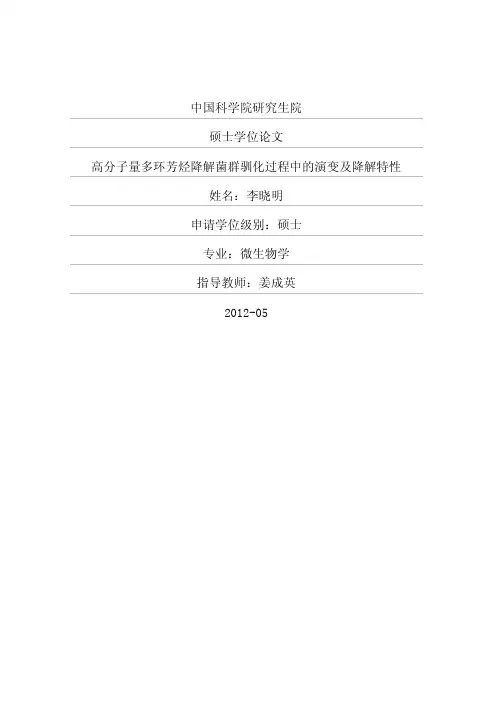
中国科学院研究生院硕士学位论文高分子量多环芳烃降解菌群驯化过程中的演变及降解特性姓名:***申请学位级别:硕士专业:微生物学指导教师:***2012-05摘要摘要将焦化厂污染土壤样品,在以芘、荧葸作为底物的矿物盐(MSM)培养基中富集驯化,得到两个能够降解高分子量多环芳烃的混合菌群(芘驯化菌群P,荧葸驯化菌群F)。
通过培养和非培养方法进行了菌群多样性调查。
通过构建16SrRNA基因文库的方法,分析焦化厂原始土壤中菌群组成和混合菌群转接3次(P.3,F.3)、6次(P.6,F.6)和9次(P.9,F.9)后的组成变化。
系统进化分析表明(1)变形菌纲是土壤原样及P.3,F.3混合菌群中的主要类群,分别占100%,83%和71%:(2)与原土壤样品相似,P.3中y-Proteobacteria(占变形菌门的77%)中假单胞菌属的菌依然占主导地位,但由于菌群的多样性增加,假单胞菌属所占比例减少。
传代过程中,菌群组成发生改变,随着传代次数的增加,菌群的多样性进一步增加,),-Proteobacteria的比例在混合菌群中的比例下降(P.6中占变形菌门的33%,P.9中占变形菌门的18%),而13-Proteobacteria在混合菌群中的比例上升(P.6中占变形菌门的36%,P.9中占变形菌门的55%);F菌群中IB-Proteobacteria的比例也逐渐上升(F.3,30%;F.6,63%;F.9,76%),而0‘.Proteobacteria和y-Proteobacteria的组成比例逐渐下降(F.3,41%,27%;F.6,20%,15%:F.9,13%,10%。
)。
通过培养,从混合菌群中分离纯化得到17株菌,系统进化分析表明分别属于Achromobacter,Bacillus,Microbacterium,Arthrobacter,Exiguobacterium,Alcaligenes和Parapedobacter属。
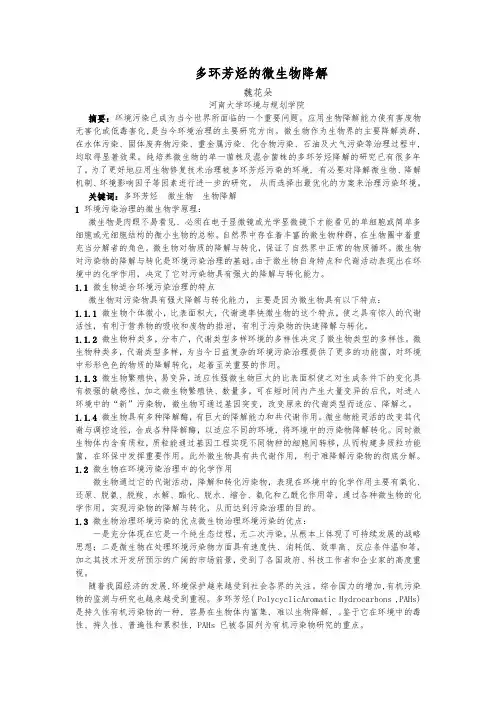
多环芳烃的微生物降解魏花朵河南大学环境与规划学院摘要:环境污染已成为当今世界所面临的一个重要问题。
应用生物降解能力使有害废物无害化或低毒害化,是当今环境治理的主要研究方向。
微生物作为生物界的主要降解类群,在水体污染、固体废弃物污染、重金属污染、化合物污染、石油及大气污染等治理过程中,均取得显著效果。
纯培养微生物的单一菌株及混合菌株的多环芳烃降解的研究已有很多年了。
为了更好地应用生物修复技术治理被多环芳烃污染的环境, 有必要对降解微生物、降解机制、环境影响因子等因素进行进一步的研究,从而选择出最优化的方案来治理污染环境。
关键词:多环芳烃微生物生物降解1环境污染治理的微生物学原理:微生物是肉眼不易看见、必须在电子显微镜或光学显微镜下才能看见的单细胞或简单多细胞或无细胞结构的微小生物的总称。
自然界中存在着丰富的微生物种群,在生物圈中着重充当分解者的角色。
微生物对物质的降解与转化,保证了自然界中正常的物质循环。
微生物对污染物的降解与转化是环境污染治理的基础。
由于微生物自身特点和代谢活动表现出在环境中的化学作用,决定了它对污染物具有强大的降解与转化能力。
1.1 微生物适合环境污染治理的特点微生物对污染物具有强大降解与转化能力,主要是因为微生物具有以下特点:1.1.1微生物个体微小,比表面积大,代谢速率快微生物的这个特点,使之具有惊人的代谢活性,有利于营养物的吸收和废物的排泄,有利于污染物的快速降解与转化。
1.1.2微生物种类多,分布广,代谢类型多样环境的多样性决定了微生物类型的多样性。
微生物种类多,代谢类型多样,为当今日益复杂的环境污染治理提供了更多的功能菌,对环境中形形色色的物质的降解转化,起着至关重要的作用。
1.1.3微生物繁殖快,易变异,适应性强微生物巨大的比表面积使之对生成条件下的变化具有极强的敏感性,加之微生物繁殖快、数量多,可在短时间内产生大量变异的后代,对进入环境中的“新”污染物,微生物可通过基因突变,改变原来的代谢类型而适应、降解之。
应用与环境生物学报 2003,9(6):639~641 Chin J Appl Environ Biol=ISSN10062687X 2003212225多环芳烃降解菌的获得及应用3韩清鹏33 方 秦利峰 王平(浙江大学生物医学工程系 杭州 310027)摘 要 运用双相(水-硅油)系统可进行有机物降解菌的筛选.本实验用此法获得了多环芳烃(PAHs)的降解菌,降解菌对PAHs有较好的降解作用.堆肥法处理PAHs中接入筛选到的降解菌可以大大加强降解效果.堆肥过程中堆温升高很快,对一些PAHs如荧蒽、芘、苯并[a]芘等可以彻底清除,对更多环的PAHs也可降到很低的浓度.图1表3参4关键词 多环芳烃;降解;水-硅油系统C LC X172PAH s2DEGRADING MICROORGANISMS AN D THEIR APPL ICATION3HAN Qingpeng33,FAN G Fang,Q IN Lifeng&WAN G Ping(Biomedical College,Zhejiang U niversity,Hangzhou 310027,China)Abstract The biphasic aqueous-organic system(water-silicon oil system)is useful to select the microorganisms degrading PAHs.The degrading microorganisms were obtained in the experiment and were inoculated in compost to degrade PAHs.The degrading effect was evident.While composting temperature raised quickly.S ome PAHs could be degraded thoroughly but some PAHs with more rings could also be degraded in a fairly low level.Fig1,Tab3,Ref4K eyw ords PAHs;degrade;biphasic system;compostC LC X172 多环芳烃(polycyclic aromatic hydrocarbons,简称PAHs)主要来源于煤焦油、杂酚油和石油以及有机质不完全燃烧而产生的污染物.由于它们在环境中的化学稳定性高、水溶性低且长期残留,致癌致畸且有毒,因此解决这类化合物引起的污染问题是非常有意义的.多环芳烃理化性质不相同,反映出的生物降解性也各不相同.一般说来,多环芳烃的降解性随苯环数量的增加而降低,三环以下的易于降解,四环以上的较难降解[1].研究多环芳烃这一类难降解有机物的生物降解过程,首要问题是筛选降解菌.只有分离到降解菌后,才能作进一步的理论研究和用于生物修复PAHs的污染.用一种水-硅油双相系统可进行对PAHs类难降解物质的降解菌的富集、筛选[2,3].把获得的降解菌接入多环芳烃污染的堆肥中可加速多环芳烃的降解.本文研究了用水-硅油双相系统筛选多环芳烃降解菌,并把降解菌用于含有PAHs的污染物中进行堆肥处理.1 材料与方法1.1 多环芳烃的来源某化工厂的工业废物酸焦油,系有机液体和固体混合物,其中固体废渣占36.3%(质量分数),酸焦油为1719~19536 mg/kg,其中苯并芘(B[a]P)为3567mg/kg,15种PAHs含量之和为96999mg/kg,占酸焦油总量的9.7%.酸焦油用φ= 1/11的甲苯溶解.收稿日期:2002210211 接受日期:20022122033国家自然科学基金资助项目(No:29577269) Supported by the Na2 tional Natural Science Foundation of China33通讯作者 Corresponding author 1.2 水-硅油两相系统组分硅油系高纯度的液体,成分为聚二甲基硅氧烷醇,分子量2000左右,运动粘性系数20×10-2m2/s,密度为0.95,表面张力为20.6×10-5N/cm,阶电常数为2.72.无机盐培养液配方如下(ρ/mg L-1):K2HPO4775, KH2PO4350,(NH4)2SO4・7H2O100,FeSO4・7H2O1,MnSO4・H2O1,Na2MoO40.21,CaCl240(培养基1)[3].1.3 富集降解菌的方法在水-硅油系统中富集.每个250mL的三角瓶中加入80 mL的无机盐培养液和20mL的硅油,加入待降解物作为碳源,加入污染物作为菌源,室温30℃下培养,振荡速度为120 r/min.经过一段时间的生长后,可见液体浑浊而且p H下降,取5mL的上述液体加入另外一个装有同样物质的三角瓶,作为对照(CK)[3].1.4 PAHs降解菌的分离在无机盐固体培养基上涂布菌液.然后喷涂溶有PAHs的乙醚溶液,乙醚很快挥发,PAHs留在培养基上,PAHs的浓度与水-硅油系统富集PAHs降解菌时的PAHs浓度相同.待菌长出后,进一步纯化菌种,保存.1.5 混合菌在水-硅油系统中对PAHs的降解效果的测定在含有PAHs的水-硅油系统中接入活化的PAHs降解菌,15d后用HPLC色谱仪测定PAHs的残留.1.6 用堆肥法结合接种降解菌处理多环芳烃中的实验以鸡粪和树叶及土壤为原料堆肥(C N=25 1).堆肥容器为圆筒形容器(内径20cm,高65cm).由于堆肥体积小,为了避免堆肥堆温上升后热量的散失,外用木屑保温,顶部使用具孔的盖子盖顶,起到保温遮光的作用,同时也可满足通气的要求.往堆肥中加入酸焦油的浓度为280mg/kg ,同时接入5%左右的降解菌(液体培养3~5d 后)接入堆肥中,监测堆肥温度的变化,在堆肥初期、升温期末、高温期末、降温期末和腐熟期末翻堆、采样,测定水分变化,并将水分含量控制在60%左右.1.7 堆肥样品的提取和浓缩[4]称取1.00g 污染样物置于10mL 具塞玻璃离心管中.加入2.00g 的无水Na 2SO 4混匀,加入10mL 混合溶剂(V 二氯甲烷 V 丙酮=2 1),放置75~90min ,超声提取20min ,以2500r/min ,离心5min ,将上清夜转移至T 2D 浓缩管,再往离心管中加入8mL 混合溶剂,放置60min ,超声提取15min ,以2500r/min ,离心3min ,将上清夜与上次提取液合并K 2D 浓缩管中,用常量、微量Snyder 柱浓缩至1.0mL 以下(水浴温度69~75℃),用丙酮定溶至1.0mL ,过滤,同时进行溶剂空白实验.所有操作均在避光条件下进行.同时称取2.00g 的样品,测定样品的含水量.1.8 多环芳烃的测定方法分析仪器为岛津LC100型液相色谱仪,紫外线检测器,波长为254nm ,样品分析时间为30min ,打印时间为60min ,进样过程:B 泵水流速为0.1mL/min ,A 泵甲醇流速为0.4mL/min ,进样11min 后梯度洗脱40min 洗完.标准样品:16种多环芳烃标准储备液.用保留时间和峰高测定PAHs ;以PAHs 混合标准液为外标,定量计算PAHs 的浓度.2 结果与讨论2.1 利用水-硅油系统筛选PAHs 降解菌2.1.1 降解菌的富集和分离 在上述水-硅油两相系统中富集得到降解菌.每隔3d 测定微生物数目,选用含葡萄糖的培养基培养,获得总菌数.微生物生长见表1.表1 水-硅油系统富集PAHs 降解菌不同时间微生物的生长Table1 Growth of PAHs 2degrading microorganismsin the biphasic systemt /d 03691215n /mL-15×1065×1061×1078×1071.5×1081×108 由表1可知,d 12菌数达到1.5×108mL -1,微生物生长旺盛.可以进行下一步的分离.在无机盐固体培养基上涂布菌液,然后喷涂溶有PAHs 的乙醚溶液.乙醚随后挥发.待菌长出后,进一步纯化分离,得到三株降解菌,一种为霉菌,两种细菌,待鉴定.先编号为S1,S2,S3.前两株为细菌,后一株为霉菌.2.1.2 降解菌降解效果的测定 在含有多环芳烃的水-硅油两相系统中接入降解菌,培养15d 后,测定降解效果如表2.由表2可知,从两相系统中筛选得到的降解菌对各种PAHs 均有降解,对环较少的PAH 降解效果较好,如对萘、苊烯、菲、蒽和芴的降解比较彻底.降解菌对环较多的PAHs ,如荧蒽、芘、苯并[a ]芘、苯并[ghi ]北的降解效果就差一些.运用双相系统在15d 内筛选到了PAHs 降解菌.与别的方法相比,水-硅油系统提供给微生物一个特殊的有机相环境(PAHs 溶解在硅油里面),可以避免PAHs 对微生物的抑制,并且提高微生物的代谢功能.在此系统中PAHs 的浓度较高(PAHs 总浓度为1.45g/L ),可以提供充分的碳源和能源,PAHs 是一类理化性质各不相同的物质,因此此降解过程中有共代谢作用和微生物之间的相互作用,在富集中会提高选择的程度.实际应用的菌为混合菌.这与在自然环境中混合菌作用于不同污染物的过程是相似的.表2 降解菌在水2硅油系统中对PAHs 地降解效果Table 2 Degradation of PAHs in the biphasicsystem by the microorganisms名称Name降解菌降解效果Degradation results非生物降解率Abiotic deg 2radation rate生物降解率Biological deg 2radation rate总去除率Total remov 2al rate 萘Naphthalene 无No81.781.7苊烯Acenaphthene 3.796.3100苊+芴Fluerence 2.787.189.8菲Phenanthrene 无No 92.292.2蒽Anthracene 无No 100100荧蒽FA 5.654.359.9芘Pyrene17.841.359.1苯并[a ]芘B[a ]P2.854.657.4苯并[ghi ]北B[ghi ]Pe 7.630.838.4 3非生物降解率的测定为对照处理,即不接种菌的降解如光解和物理、化学作用 Indicating CK2.2 降解菌在堆肥处理多环芳烃的应用2.2.1 接种降解菌处理PAHs 的堆肥温度变化 本实验中温度随时间的变化曲线如图1所示.由图1可知,加入降解菌F 0d 2就开始升温,d 4升到30℃以上,d 9达到高温峰值58℃,高温阶段持续6d ,并维持一个动态平衡状态,此时高温菌分解有机物的产热量和堆体的散热量相平衡.可明显看到堆肥发白,质地疏松变轻.加菌的温度曲线有两个峰,前一个峰为降解菌利用堆肥材料的温度峰值,后一个峰为降解菌降解PAHs 时的温度峰值.而不加菌的堆肥对照升温比较缓慢,d 8才升到30℃,且速度缓慢,高温期维持为6d ,最高温度也没有加菌的高,为47℃,原因可能是由于污染基质含量高,造成对土著微生物的危害.而外加降解菌可以迅速适应环境,提前进入启动期,并对多环芳烃进行降解.图1 堆肥温度随时间变化图Fig.1 The changing temperature in the courseof composting2.2.2 PAHs 的降解 在堆肥不同的时期取样,测定PAHs 的降解情况,结果如表3.046 应用与环境生物学报 Chin J Appl Environ Biol 9卷表3 堆肥加菌与不加菌处理PAHs在不同时期的降解情况Tab3 Comparison of degradation ofPAHs with and without inoculating microorganisms多环芳烃PAHs w0/mg kg-1加菌后浓度Concentrations after adding withmicroorganisms(w/mg kg-1)20d50d不加菌50d后浓度C oncentrations50d a fter n ot adding with m icroorgan2isms(w/mg kg-1)荧蒽FA935.8190.0000芘Pyrene126.0080.0000苯并[a]蒽B[a]F335.8490.000139.00屈Chrysene1422.86360.000347.00苯并[b]荧蒽B[b]F1390.002220.000323.00苯并[k]荧蒽B[k]F390.00470.00080.00苯并[a]芘B[a]P1163.68750.000335.00二苯并蒽Dibenzanthracene6816.801870.001052.543455.75茚并芘Indeno pyrene852.00450.00743.501181.40苯并北B[ghi]Pe4050.002430.002530.692613.90 接种降解菌对那些环比较少的有明显降解.堆肥处理50d后,接种降解菌的堆肥中多种PAHs的浓度降为0.只有茚并芘、二苯并蒽和苯并北还有残留,但仍比不接种降解菌的浓度要低.不接种降解菌的堆肥中环少的PAHs的浓度也降至0,但是大多数PAHs仍有残留.其中茚并芘50d后的浓度反而比初始值高.在加菌处理前20d就基本达到了不加菌处理50d的降解水平.不同的PAHs在加菌处理过程中的降解趋势是不同的.环少的很快就被降解掉.环多的就相差很大,苯并[b]荧蒽、苯并[k]荧蒽、屈、苯并芘、二苯并蒽的浓度越来越低.而茚并芘和苯并北的降解却是先低后高,但是仍然比初始值低.R eferences1 钱易.重点有机污染物生物降解性能评价.环境科学,1986,7(2): 86~932 Spain J C,Nishiino SF.Degration of1,42dicholorobenzene by a Pseu2 domonas sp.A ppl Envi ron Microbiol,1987,53:1010~10193 Migual Ascon2cabrera et al.Selection of xenobiotic2degrading microor2 ganisms in a biphasic aqueous2organic system.A ppl Envi ron Microbi2 ol,1993,59:1717~17244 He YW(何耀武),Ou ZQ(区自清),Sun TY(孙铁衍).Adsorption of polycyclic aromatic hydrocarbons on soils.Chi n J A ppl Ecol(应用生态学报),1995,6(4):423~427146 6期韩清鹏等:多环芳烃降解菌的获得及应用 。
高相对分子质量多环芳烃的生物共代谢降解
高相对分子质量多环芳烃是一类有机污染物,它是生物共代谢降解过程中极具挑战性的无机污染物。
高相对分子质量多环芳烃是由多个碳原子与氢原子组成的有机复合物,是由医药、油脂、颜料及橡胶的衍生物等工业上制品的废弃物所构成的污染物。
这类有机污染物的降解对于环境保护来说极具重要性,可以减少环境污染,改善环境质量,改善公民健康。
高相对分子质量多环芳烃的生物共代谢降解是指:自然微生物利用高相对分子质量多环芳烃作为唯一的碳源,进行共同代谢过程中利用菌体的细胞酵素对它进行碳氢键的切断、分解,将高相对分子质量多环芳烃分解为水及碳二氧化碳,以空气为氧源的过程。
研究表明,有一些特定的微生物可以通过生物共代谢降解高相对分子质量多环芳烃。
生物共代谢降解高相对分子质量多环芳烃,是在脱氢降解和介电效应改性处理技术的基础上实现的有效降解技术。
它首先用一种可溶性脱氢酶将有机复合物分解为低分子量有机物,然后在电位负极处将低分子量有机物进一步氧化分解,从而有效减少提高悬浮物的总有机碳和提高改善温室效应气体的排放。
生物共代谢降解高相对分子质量多环芳烃能够实现更有效的污染物降解,有很多实际应用,如废水,废气和土壤修复等。
所以,对于高相对分子质量多环芳烃的生物共代谢降解,具有重要意义和行之有效的应用。
应用与环境生物学报 2003,9(4):433~435 Chin J Appl Environ Biol=ISSN1006 687X 2003 08 25多环芳烃降解菌ZL5分离鉴定及其降解质粒*张杰 刘永生 冯家勋1 柏学亮1 张忠泽**(中国科学院沈阳应用生态研究所 沈阳 110015)(1广西大学分子遗传研究所 南宁 530005)摘 要 通过选择性富集培养,从辽河油田石油污染土壤中分离到一株多环芳烃(PAHs)降解菌ZL5.它能以菲和芘为唯一碳源生长,但是不能利用萘.16S rD NA核苷酸序列分析结果表明,ZL5属于变形细菌 亚类中的鞘氨醇单胞菌属.该菌株含有一个大小约为60kb的质粒.丝裂霉素C消除实验表明,随着质粒的丢失,菌株利用菲和芘的能力也丧失.用电转化和氯化铷转化法分别将菌株ZL5的质粒导入大肠杆菌JM109和DH5 中,随着质粒的获得,这些转化子获得了降解菲和芘的能力.本研究结果表明,鞘氨醇单胞菌ZL5降解PAHs的功能和质粒有关.图4参16关键词 多环芳烃(PAHs);16S rDN A;鞘氨醇单胞菌;降解质粒C LC X172ISO LATION AND IDENTIFICATIO N OF PAHS-DEGRADINGSTRAIN ZL5AND ITS DEGRADATIVE PLASMID*ZHANG Jie,LIU Yongsheng,FENG Jiaxun1,BAI Xueliang1&ZHANG Zhong ze**(I nstitute of A pplied Ecology,Chine se A cademy of S ciences,Shenyang 110015,China)(1I nstitute of M olecular Genetics,Guangxi University,Nanning 530005,China)Abstract T hroug h selective enrichment culture,a PAHs-degrading bacter ial strain ZL5w as isolated from oil-contaminat ed soil in Liaohe Oil F ield.T he strain w as able to use phenanthrene and pyrene as the sole carbon source for grow th,but could not utilize naphthalene.T he sequence analysis of16S r DNA show ed that ZL5belongs to Pr oteobacteria alfa subdiv i sion;Sp hingo monas.A plasmid,appro ximately60kb in size,was detected from strain ZL5.T he str ain lost the abilit y to degrade phenanthrene and py rene when its plasmid w as eliminated by mitomycin C.T he transfo rmants obtained t he ability to degrade phenanthrene and py rene when the plasmid of strain ZL5was transfor med to Escher ichia coli JM109through electropor atio n and Rbcl transformation.T his w ork indicates that the plasmid of str ain ZL5could be r esponsible for the degradatio n of PAHs.F ig4,Ref16Keywords PAHs;16S r DNA;Sp hingomonas;degr adative plasmidC LC X172多环芳烃(PAHs)是一类由两个或两个以上苯环组成的有机化学污染物,主要存在于石油污染的土壤和河流中,具有潜在的致突变、致畸、致癌效应.萘、菲、芘是常见的多环芳烃化合物,研究表明微生物特别是鞘氨醇单胞菌能很好消除其污染[1~3].但关于鞘氨醇单胞菌对PAHs降解的研究,目前国内尚未见报道.本文描述了降解PAHs的鞘氨醇单胞菌ZL5分离、鉴定及其降解特性,并初步探索了该菌的降解机制.1 材料与方法1.1 样品来源土样采自辽河油田石油污染地.1.2 菌株及分子生物学试剂大肠杆菌JM109和DH5 购于Promeg a公司,T aq DNA收稿日期:2002 08 21 接受日期:2002 10 16*中国科学院知识创新工程资助项目(KZCX2-401) S upported by the Know ledge Innovation Project of the Chinese Academy of S ciences **通讯作者 Corresponding author 聚合酶购自大连宝生物公司,核酸限制内切酶为Promega公司产品,胶回收试剂盒是上海华舜公司产品,琼脂糖购自FM C 生物制品公司,其它为国产分析纯试剂.1.3 培养基1.3.1 LB培养基和L B固体培养基 参见文献[4].1.3.2 无机盐基础培养基( /g L-1) M g SO4 7H2O0.2, CaCl2 2H2O0.02,F eSO4 7H2O0.01,KH2PO40.4,N a2HPO4 0.6,M nSO4 H2O0.02,NH4NO31.0,葡萄糖0.5,蒸馏水定容至1.0L,pH7.0,121 蒸汽灭菌30min.1.3.3 菲无机盐液体培养基 以丙酮配制1%的菲溶液, 0.25 m滤膜除菌,量取一定量的菲溶液置于灭菌的三角瓶中,待丙酮挥发完毕,加入已灭菌不含葡萄糖的无机盐基础培养基,使菲终浓度为0.2%.1.3.4 萘、菲、芘无机盐固体培养基 向不含葡萄糖的无机盐基础培养基中分别加入萘、菲、芘的丙酮溶液,使其终浓度分别为0.01%、0.01%、0.005%,再加入1.5%琼脂粉,121 蒸汽灭菌30min.1.4 菌株驯化和分离向盛有50mL 菲无机盐液体培养基的250mL 三角瓶中加入1g 土样,30 ,200r /min,摇床培养5d,按10%接种量转接到新鲜的菲无机盐培养基中,继续培养5d,反复5次.最后吸取0.1mL 培养液稀释不同梯度涂布于菲无机盐平板上,挑取单菌落,将平板划线纯化后的单菌落再接种到菲无机盐液体培养基中,选取生长速度最快的菌株作为研究菌株.将其分别接种到以0.01%萘和0.005%芘为唯一碳源的无机盐固体培养基上,观察对萘和芘的利用情况.以上均在暗室培养,避免PAHs 被光解.1.5 菌株鉴定采用16S rDNA 序列分析、染色及形态观察等方法.以ZL 5菌株的总DN A 为模板,以F27(5 -AG AGT T T GA T CAT GGCT CA G -3 )和R 1497(5 -T ACG GT T ACCT T G T T ACGACT T -3 )为引物扩增其16S r DNA [5].PCR 反应体系和反应程序见文献[4].PCR 反应产物的纯化按照上海华舜生物工程有限公司的胶回收试剂盒操作手册进行.16S rDNA 的序列测定在AB1377型DNA 测序仪上完成,测序结果用G en Bank 中的Blast 软件进行同源性比较.1.6 质粒提取参照Kado 和liu 提取大质粒的方法[6].1.7 质粒单酶消化分别用Bam H 、Eco R 、H in d 、Pst 、Xho 、X ba 、Sal 和N ot 消化质粒,酶切产物分别用0.7%和1%的琼脂糖凝胶电泳,将各个酶切片段和分子量标记片段比较,累加酶切片段,得出质粒的大小.1.8 质粒功能鉴定采用丝裂霉素C 消除法[7]、电转化和氯化铷转化法[4].1.9 抗生素抗性测定分别向灭菌的LB 培养基中加入不同浓度的各种抗生素,接入相同的菌液量,观察菌体的生长情况.2 结果与讨论2.1 PAHs 降解菌株的分离和鉴定经多次富集培养获得一株能以菲为唯一碳源快速生长的细菌,命名为ZL 5.将该菌株划线接种到以萘或芘为唯一碳源的无机盐固体培养基上,观察结果表明ZL5在萘平板上不生长,在芘平板上生长.显微镜下观察ZL 5是棒状杆菌,革兰氏染色阴性,不形成孢子,单生极性鞭毛运动.对菌株ZL5的16S r DNA 进行PCR 扩增,获得约1.5K b 大小的PCR 产物(图1),用Blast 软件分析此片段的测序结果,表明ZL 5与Sp hin gomonas sp.BRW2,Sp hingomonas sp.K 74和Sp hingomonas her bicidovor ans 等多株鞘氨醇单胞菌属(Sp hingomonas sp)的菌株同源性均为98%.根据ZL5菌株的16S rDN A 和鞘氨醇单胞菌属的菌株具有高度的同源性,将菌株ZL 5初步鉴定为鞘氨醇单胞菌属.学者们对鞘氨醇单胞菌认识较晚,Y abuuchi 等[8]在1990年首次描述了鞘氨醇单胞菌属的特征,T akeuchi 等[9]于1993年对此又做了修正.鞘氨醇单胞菌属的菌株属于变形细菌 亚类,是革兰氏阴性菌,但和典型的革兰氏阴性菌株又不同,其细胞膜不含有脂多糖,而是由糖鞘脂组成,糖鞘脂通常是构成真核细胞细胞膜的成分.近年研究表明,鞘氨醇单胞菌属的菌株能够降解多种芳香族化学污染物,例如降解二甲苯、联苯[10],甲苯、萘[3]、菲[1,2],芳香环杀虫剂虫螨威(又名卡巴呋喃carbo fur an)[11],萘磺酸盐(naphthalenesulfonate)[12]等.本实验分离到的鞘氨醇单胞菌ZL5能够降解菲和芘,但是不能降解萘.此种菌株往往有它独特的代谢菲的途径.一般能降解菲的细菌也能降解萘,它们通过常规的水杨酸和儿茶酚途径代谢菲[13].这种能降解菲而不能利用萘的细菌菌株是通过原儿茶酸盐途径代谢菲[14].图1 ZL5菌株16S rDNA 的PCR 产物Fi g 1 PCR product of 16S rDNA from strain ZL5M :1kb marker;1:PCR product of 16S rDNA2.2 质粒提取和酶切分析据Kado 和liu 快速提取大质粒的方法介绍,将菌体悬浮,加入裂解液以后在50 水浴一定时间,一般为20min,可以将染色体完全去除.本实验将菌体悬浮液加入裂解液以后在50 分别水浴不同时间(0min,10min,20min 和40min)都能稳定地获得菌株ZL 5的大质粒,但是延长水浴时间并没有完全去除染色体(图2),这可能和菌株自身特性有关.该质粒为低拷贝,用电洗脱法大量回收质粒,然后分别用各种限制内切酶消化,分析结果表明菌株ZL5质粒的大小约为60kb(图略).图2 50 水浴不同时间获得的ZL5菌株质粒Fi g 2 Plasmid of strai n ZL5obtained from the treatment ofincubating at 50 for different ti m e M : DNA/Hin d marker;1:0min;2:10min;3:20min;4:40min2.3 质粒功能鉴定用2 g/mL 的丝裂霉素C 处理菌株ZL5,获得在LB 固体434 应用与环境生物学报 Chin J Appl Environ Biol 9卷培养基上生长,但是在以菲和芘为唯一碳源的无机盐培养基平板上不生长的突变体M a,其质粒已被消除(图3).突变体M a 经16S r DNA 鉴定,为鞘氨醇单胞菌,非污染菌株.随着质粒的消除,菌株降解菲和芘的能力丧失,表明菌株ZL5降解菲和芘的功能与质粒有关.用电转化法将菌株ZL5的质粒导入E.coli JM 109中,获得4个能在以菲和芘为唯一碳源的无机盐培养基上生长的转化子,提取质粒验证,4个转化子均含有与ZL 5相同的大质粒(图4),这进一步证明菌株ZL 5的内生质粒共有降解菲、芘的功能.用氯化铷转化法向E.coli DH5 中导入ZL 5质粒,获得2株能在以菲和芘为唯一碳源的无机盐培养基平板上生长的转化子,经验证转化子均含有大质粒(图4).抗生素抗性测定表明,菌株ZL 5能够抗氨苄青霉素(100 g/mL)、链霉素(50 g /mL )和利福霉素(100 g/mL ),对四环素、氯霉素、庆大霉素十分敏感.消除质粒的突变体M a 仍具有这些抗性,获得质粒的转化子没有获得相应的抗性,这说明该质粒和抗生素抗性无关,这种抗性是由染色体控制.图3 丝裂霉素C 处理菌株ZL5获得的消除质粒突变体M a Fig 3 M utant of strain ZL5cured of the pl asmid by m i tomycin CM : DNA/Hind mak er;1:ZL5;2:突变体M utant Ma图4 电转化和氯化铷转化法获得菌株ZL5的转化子Fig 4 Transformants of s train ZL5from electro porationand RbCl transformationM : DNA/Hind maker;1:ZL 5;2~5:电转化转化子T ransformants obtained by electroporation;6,7:氯化铷转化子Transformants obtained by RbCl transformation目前研究表明,负责PAHs 降解的基因簇有的位于染色体上[15,16],有的位于质粒上[1,13,14].本研究通过丝裂霉素C 消除法和转化法表明与PAHs 降解有关的基因位于菌株ZL5的内生质粒上,为下一步克隆其相关基因打下了基础.References1 C ho JC ,Kim SJ.Detection of mega plasmid from polycyclic aromatichydrocarbon-degrading Sphingomonas sp.strain 14.J M ol M icrobiol Biotechnol ,2001,3(4):503~5062 Kim SJ,Chun J,Bae KS.Polyphasic assi gnment of an aromatic degrading Pseud omonas sp.,strai n DJ77,i n the genus Sphingomonas asSp hingomonas chungbukensis sp.nov.Int J Syst Ev ol M icrobiol ,2000,50(4):1641~16473 Fredrickson JK,Balkw ill DL,Drake GR.Aromatic-degrading Sp hin gomonas isolates from the deep subsurface.App l Env ir on M icrobiol ,1995,61(5):1917~19224 S ambrook J,Fritsch EF,M aniatis T.M olecular Cloning :A LaboratoryM anual .2nd Ed.New York:Cold Spring Harbor Laboratory Press,19895 W eisburg WG,Barns S M ,Pelletier DA.16s ri bosomal DNA am plifica tion for phylogenetic study.J Bacteriol ,1991,173(2):697~7036 Kado CI,Liu ST.Rapid procedure for detection and isolation of largeand small plasmids.J Bacteriol ,1981,145(3):1365~13737 Chakrabarty AM.Genetic basis of th e biodegradation of s alicylate in Pseud omonas .J Bacteriol ,1972,112(2):815~8238 Yabuuchi E,Yano I,oyaizu H .Proposal of Sp hingomonas p aucimobilis gen.nov.and comb.nov.,S phingomonas p arap aucimobilis sp.nov.,Sp hingomonas yanoikuyae sp.nov.,Sphingomonas adhaesiv a sp.nov.,Sp hingomonas capsulata comb.nov.,and tw o genospecies of the genus S phi ngomonas.M icr obiol I mmu nol ,1990,34(2):99~1199 Takeuchi M ,Kaw ai F,S himada Y.Taxonomic s tudy of polyethylene glycol-uti lizing bacteria:emended description for the genus Sp hin gomonas and new descri ptions of S phing omonas macrogoltabidus sp.nov,Sp hingomonas sang uis sp.nov.and Sp hingomonas ter rae sp.nov.Syst App l M icrobiol ,1993,16:227~23810 Yrjala K,Suomalainen S ,Suhon en EL.Characterization and reclassification of an aromatic -and chloroaromatic -degrading Pseud omonas sp.,strain H V3,as Sphingomonas sp.HV3.Int J S yst Bac teriol ,1998,48(3):1057~106211 Feng XH ,Ou LT,Ogram A.Plasmid -mediated mineralization ofcarbofuran by S phingomonas sp.strain CF06.App l Env iron M icrobiol ,1997,63(4):1332~133712 Riegert U,Heiss G,Kuhm AE .Catalytic properties of the 3-chlorocatechol -oxidizing 2,3-dihydroxybiphenyl 1,2-dioxygenase from Sp hingomonas sp .strain BN6.J Bacteriol ,1999,181(16):4812~481713 M enn FM ,Applegate BM ,Sayler GS.NAH plasmid -mediatedcatabolism of anthracene and phenanthrenen to naphthoi c acids.A pplEnv iron M icr obiol,1993,59(6):1938~194214 Kiyohara H ,Nagao K,Kouno K.Phenanthrene -degrading phenotype of Alcaligenes f aecelis AFK2,App l Env ir on M icrobiol ,1982,43(2):458~46115 Saito A,Iwabuchi T,Harayama S.A novel phenanthrene dioxygenasefrom Nocardioides sp,strain KP7:expression in Escherichia c oli ,J Bacteriol ,2000,182(8):2134~214116 Kiyohara H ,T origoe S ,Kai da N.Cloning and characteri zation of achromosomal gene cluster,pah ,that encodes the upper pathw ay for ph enanthrene and naphthalene uti li zation by Pseudomonas pu tida OUS82.J Bacter iol ,1994,176(8):2439~2443435 4期张杰等:多环芳烃降解菌ZL5分离鉴定及其降解质粒。